Ouch, what bit me? 10 common bug bites
While some bites and stings are harmless, others could send you to the emergency room.
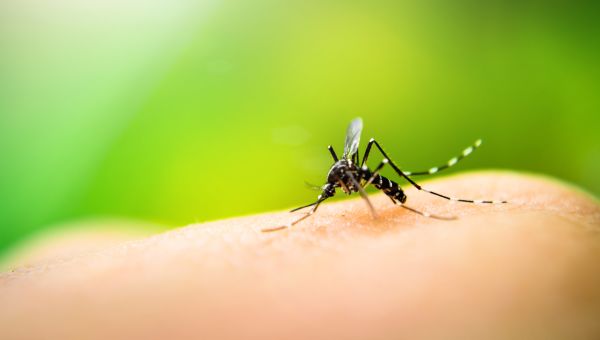
Summer brings backyard barbecues, picnics in the park, and days spent laying on the beach or beside the pool. Unfortunately, the season is also peak time for buzzing and biting insects like mosquitos, spiders, and ticks. Irritating bug bites are often harmless, but some are painful and may cause an allergic reaction, infection, or worse.
It can be difficult to spot the… Show More
Summer brings backyard barbecues, picnics in the park, and days spent laying on the beach or beside the pool. Unfortunately, the season is also peak time for buzzing and biting insects like mosquitos, spiders, and ticks. Irritating bug bites are often harmless, but some are painful and may cause an allergic reaction, infection, or worse.
It can be difficult to spot the difference between an innocent welt and a dangerous one, but there are ways to identify what bit or stung you. Gabriel Schifman, DO, a pediatrics and pediatric emergency medicine specialist with Overland Park Regional Medical Center in Overland Park, Kansas, shares how to determine the cause of your discomfort, ways to treat it, and tips for preventing bites and stings.

Mosquito Bites
Red and raised, mosquito bites are among the most common causes of insect-related itch. Aside from a little irritation, they're usually harmless and will clear on their own in just a few days.
Not everyone has the same reaction, though, and it’s possible for a bite to result in small blisters,… Show More
Red and raised, mosquito bites are among the most common causes of insect-related itch. Aside from a little irritation, they're usually harmless and will clear on their own in just a few days.
Not everyone has the same reaction, though, and it’s possible for a bite to result in small blisters, multiple bumps, or bruise-like spots. But there is still no need to worry. However, in some rare cases, a headache, chills, fever, and vomiting can occur and should be reported to an emergency medical professional immediately.
Like many insects, some mosquitoes carry diseases like Zika, West Nile virus, and Dengue fever. If you develop a fever or flu-like symptoms after being bitten, you should see your healthcare provider (HCP). Infection is another reason to visit an HCP. Although uncommon, scratching can force bacteria from under your fingernails into the skin.
Barring illness and infection, symptoms can be treated with topical itch-relief ointments and cold compresses. If you’re going to be outside, Schifman recommends wearing protective clothing and applying bug repellant that contains between 10 and 30 percent DEET.
Show Less
Bee Stings
Their distinct buzz has sent school kids scampering for centuries, and rightfully so—getting stung by a bee hurts. More often than not, bee stings are harmless, but if you’re stung more than once, or you’re allergic to the creature’s venom, a nuisance can turn into a medical emergency.
“Bees can… Show More
Their distinct buzz has sent school kids scampering for centuries, and rightfully so—getting stung by a bee hurts. More often than not, bee stings are harmless, but if you’re stung more than once, or you’re allergic to the creature’s venom, a nuisance can turn into a medical emergency.
“Bees can actually leave the stingers in the skin,” Schifman says. “If you do see a stinger, that could be indication you’ve been stung."
Bee stings often cause pain, redness, and swelling at the site, all of which should clear within a few hours. In more serious instances, the welt may grow and can last up to 10 days. Still, this isn’t something to worry about. If reactions to subsequent stings prove more painful, speak with your HCP about treatment and prevention. Most alarming are the severe reactions, which include symptoms like hives, difficulty breathing, nausea, dizziness, and loss of consciousness. Anaphylaxis can happen almost immediately, so prompt medical treatment is a must.
Treating mild reactions is simple: remove the stinger, wash the area with soap and water, and manage pain and swelling with a cold compress and medication. If an adverse reaction develops, call an ambulance immediately.
Stings aren’t always preventable, but wearing shoes and protective clothing can help. Stay alert and cover food and drinks tightly when eating outside.
Show Less
Wasp Stings
Signs of a wasp sting are not so different from those of a bee sting. You’ll likely experience a painful welt around the site, where the wasp released a small amount of venom. You may even notice a small white mark at the center, where the stinger punctured the skin.
It’s possible the stinger may… Show More
Signs of a wasp sting are not so different from those of a bee sting. You’ll likely experience a painful welt around the site, where the wasp released a small amount of venom. You may even notice a small white mark at the center, where the stinger punctured the skin.
It’s possible the stinger may stay in the skin, in which case it should be removed. Use your fingers, tweezers, or an object with a blunt edge, like a credit card, to scrape or pull out the stinger. Don't pinch the stinger, as this will release more venom.
Most times, wasp stings cause a mild reaction like swelling, pain, and itching at the site, which can be treated with an oral antihistamine, cold compresses, and pain relievers, if needed. Not everyone is so lucky, and allergic reactions to wasp venom can cause throat swelling, difficulty breathing, hives, and more. If you or someone near you is experiencing these symptoms, drop what you're doing and call an ambulance.
If you know you’re allergic to wasp or bee stings, ask your HCP for a prescription for a bee sting kit. Learn how to use it in case of an emergency, and carry it with you.
Show Less
Blister Beetle Reactions
Blister beetles don’t bite. Instead they release a protective chemical called cantharidin that can cause painful blisters and lesions when they're crushed on the skin.
Signs of a reaction usually appear between 24 and 48 hours after contact. Irritation from a blister beetle is mostly just annoying,… Show More
Blister beetles don’t bite. Instead they release a protective chemical called cantharidin that can cause painful blisters and lesions when they're crushed on the skin.
Signs of a reaction usually appear between 24 and 48 hours after contact. Irritation from a blister beetle is mostly just annoying, and shouldn't leave any lasting skin damage. Mild reactions don't require treatment and will heal on their own, though popping blisters can lead to infection. If you touch a blister beetle, wash your hands and don't rub your eyes. If you do, seek medical attention immediately.
Blister beetles are most often found outdoors, usually in fields in southern and eastern parts of the United States, so dress appropriately for your next hike or picnic. Should you encounter one, be mindful not to crush it when removing it from your skin.
Show Less
Flea Bites
Tiny parasites that thrive on human and animal blood, fleas live primarily on cats and dogs, though humans aren’t immune to their bites. Fleas most commonly nibble people on the legs and ankles, causing small red bumps that itch.
Because fleas don’t generally carry disease, bites are typically… Show More
Tiny parasites that thrive on human and animal blood, fleas live primarily on cats and dogs, though humans aren’t immune to their bites. Fleas most commonly nibble people on the legs and ankles, causing small red bumps that itch.
Because fleas don’t generally carry disease, bites are typically little more than a nuisance. It’s possible, however, in small children and those who are allergic, for pain and swelling to occur. Allergic reactions can also cause nausea, difficulty breathing, and swelling of the mouth and face, which should be reported promptly to a professional.
Scratching can also cause an infection, characterized by swelling and redness around the bite and even painful, swollen lymph nodes.
Oral antihistamines and anti-itch creams can treat symptoms of flea bites. Pets commonly bring these insects into the home, so speak with your veterinarian if you fear your dog or cat has fleas.
Show Less
Tick Bites
Ticks, found primarily in wooded areas, are small parasites that thrive off the blood of other creatures, including people. Ticks can be too small to see, and, in some places, transmit illnesses like Lyme disease and Rocky Mountain spotted fever. Rocky Mountain spotted fever can be contracted… Show More
Ticks, found primarily in wooded areas, are small parasites that thrive off the blood of other creatures, including people. Ticks can be too small to see, and, in some places, transmit illnesses like Lyme disease and Rocky Mountain spotted fever. Rocky Mountain spotted fever can be contracted almost anywhere in the US, but rates are highest in Arkansas, Delaware, Missouri, and Tennessee. Lyme disease is confined mostly to areas in the Northeast and upper Midwest.
Ticks burrow into your skin, so if you notice one on your body, use a tweezer to gently remove it, and if possible, keep the bug in a closed container to show your HCP. Post removal, wash your hands and the affected area with soap and water, and be on the lookout for any signs of disease or infection like a headache, flu symptoms, redness, oozing, difficulty breathing—which requires immediate attention—or a large rash. “If there's a target-like rash appearing on the skin, Lyme disease could be a concern,” Schifman says.
Barring infection, a tick bite will heal on its own, but if worrisome symptoms develop, check in with your HCP. They will diagnose the disease or infection and prescribe treatment.
Some bites can be prevented, by using repellant with DEET, wearing protective clothing, and tucking your pants into your socks when you’re in areas with ticks.
Show Less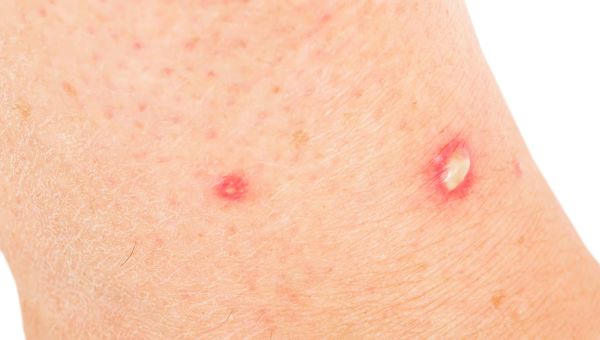
Fire Ant Stings
A cousin of the harmless black ant, the fire ant is an insect whose sting leaves you with pus-filled blisters. Although these bites look like pimples, and you may be tempted to pop them, you shouldn’t.
Fire ant stings most commonly occur on the feet and ankles, and are usually the result of… Show More
A cousin of the harmless black ant, the fire ant is an insect whose sting leaves you with pus-filled blisters. Although these bites look like pimples, and you may be tempted to pop them, you shouldn’t.
Fire ant stings most commonly occur on the feet and ankles, and are usually the result of stepping on an ant mound. They're initially painful, but within a few minutes the pain is replaced with itching and burning, which can last for a few days.
In most cases, fire ant stings are just irritating, but for some, could turn dangerous. An allergy to fire ant venom may trigger dizziness, confusion, trouble breathing, swelling of the throat, and loss of consciousness within minutes. If these symptoms arise, seek urgent medical care.
Otherwise, managing symptoms can be done at home, with cold compresses, oatmeal baths, and oral antihistamines. Avoid scratching, which can lead to infection. The best way to avoid stings is to steer clear of ant mounds and wear closed-toe shoes with socks when outdoors.
Show Less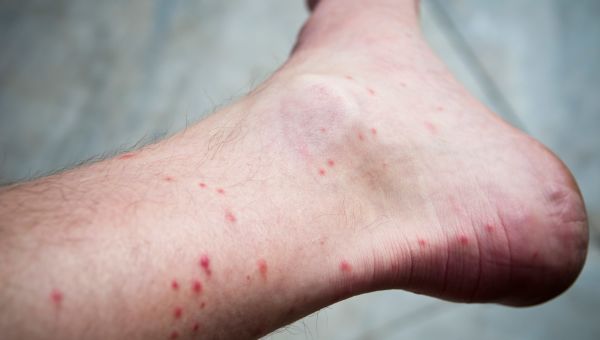
Chigger Bites
Chiggers are small bugs that are part of the arachnid family. They live in areas with tall grass and are among the most common sources of bug bites. Chiggers frequently attach themselves to skin near the ankles, around the waist, and in warm areas of the body, like the folds of the elbows… Show More
Chiggers are small bugs that are part of the arachnid family. They live in areas with tall grass and are among the most common sources of bug bites. Chiggers frequently attach themselves to skin near the ankles, around the waist, and in warm areas of the body, like the folds of the elbows and knees.
Chigger bites are initially painless, but cause itchy hives or pimple-like bumps that last about a week. If you think you’ve been bitten by these pesky insects, take a shower to remove any potentially still attached to your skin. Ice and anti-itch cream can help manage discomfort, but if the bites don’t go away, have your HCP take a look. Your physician may prescribe a steroid shot to reduce itching and swelling. “If bites get infected from scratching, they’ll need to be treated with antibiotics,” Schifman says.
If you can’t avoid areas where chiggers hide, wear long protective clothing and apply bug spray that contains DEET or permethrin, which actually kills them.
Show Less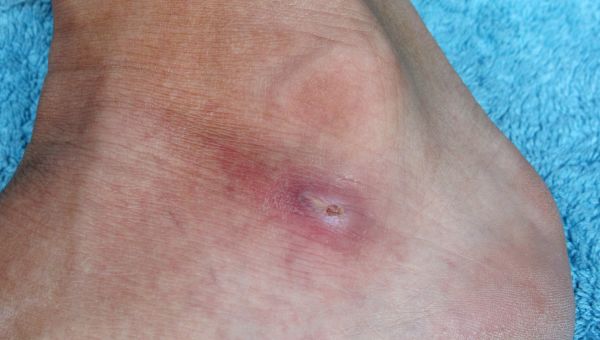
Brown Recluse Spider Bites
Most spider bites cause only minor local reactions, but brown recluse spiders, found in central and southern parts of the US like Texas, Arkansas and Louisiana, are different. They're venomous, and bites need prompt treatment. “Brown recluse bites usually have a black, necrotic center, which… Show More
Most spider bites cause only minor local reactions, but brown recluse spiders, found in central and southern parts of the US like Texas, Arkansas and Louisiana, are different. They're venomous, and bites need prompt treatment. “Brown recluse bites usually have a black, necrotic center, which spreads very quickly,” Schifman says. “They’re also a lot more painful than your typical mosquito bites."
Bites cause a mild burn around the area, followed within eight hours by redness and intense pain; it’s also possible to experience fever, chills, and body aches. In most cases, the bite will heal on its own within a week. In some cases, the bite may develop a blue or purple ring around it, which can turn into an open sore or ulcer. It may be months before an ulcer heals completely, and it should be regularly checked by your physician.
If you think you’ve been bitten by a spider, immediately clean the area with soap and water and apply an antibiotic ointment. Elevate bites on the arms and legs and apply cool compresses to help reduce pain and swelling. Over-the-counter oral pain medication can be taken if needed.
It’s possible to be allergic to brown recluse spider venom, and reactions include swelling of the mouth, difficulty swallowing, and trouble breathing, all of which need immediate professional care.
To prevent bites, keep tight spaces free of webs, wear gloves when handling firewood, and give gloves and shoes a good shake before slipping them on, especially if they’ve been unused for a while.
Show Less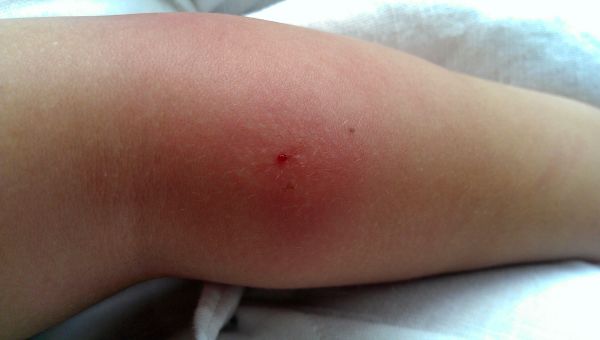
Black Widow Spider Bite
The black widow spider, famous for the red hourglass shape on its abdomen, is one of few venomous spiders found in the U.S. Unlike your average house spider, and even the brown recluse spider, a bite from this deadly arachnid can cause intense pain and stiffness in the area, muscle pain, sweating,… Show More
The black widow spider, famous for the red hourglass shape on its abdomen, is one of few venomous spiders found in the U.S. Unlike your average house spider, and even the brown recluse spider, a bite from this deadly arachnid can cause intense pain and stiffness in the area, muscle pain, sweating, nausea, numbness, and difficulty breathing.
A bite looks like two small, red dots and initially feels like a pinprick, but grows to a painful, swollen bump within 15 minutes to one hour, developing a red ring along the outside. If you notice a bite and experience symptoms, call 911 or get yourself to the emergency room. Your HCP will administer medication to help treat symptoms, and may use an antivenin to counteract the poison.
If you live in the southern half of the U.S, limit your chances of being bitten by avoiding black widow hiding places, like woodpiles and rocks. If you keep shoes and blankets in the garage, basement or mudroom, give them a good look before using them.
Show LessMore On


video

article

slideshow


video


video
